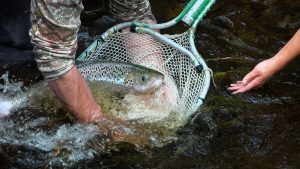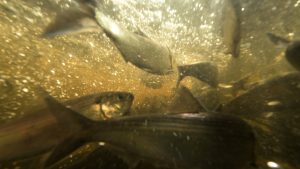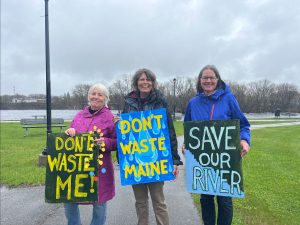DMR hearing regarding dam removal on Monday, March 15th by Mali Obomsawin with Sunlight Media Collective
For millennia, the Kennebec River was the nucleus of Wabanaki food-systems, diplomacy, and ceremonial life. After hundreds of years of industrial development, it has become unsustainable for Wabanaki peoples and our aquatic relatives alike. The future of Atlantic Salmon and several other sea-run fish now hinges on the restoration of this waterway.
The five Wabanaki nations are often described as “riverine” peoples, because the interconnected waterways of our homelands are a vital part of our cultural identities and sustenance. We have always traversed our vast territory by canoe, considering the Kennebec River as both a relative in herself and a means to reach our relatives throughout our kinship network. Using the Kennebec River system (the second largest in Maine), one can access the St. Lawrence, Androscoggin, Allagash, St. John, St. Croix, Aroostook, Sebasticook, Penobscot, and Machias rivers, and the open ocean.
Damming these rivers has been both a symptom and a strategy of colonization. In spite of this, Wabanaki people are still able to portage around obstructions in our rivers. The fish are not so privileged, and for this reason we must do everything we can to ensure their access to the expansive northeastern river systems that sustain us all.
Today, a dozen once-abundant species of fish are unable to reach their historic territories, spawning grounds, and rearing habitats along the Kennebec and its tributaries. Critically, damming has brought Atlantic salmon to the brink of extinction in this watershed and possibly across the entire continent.
Four antiquated dams above Waterville are blocking salmon’s access to their critical habitat in the Sandy River, all of which are owned by Canadian-based energy giant Brookfield Renewable Partners. These include the Hydro Kennebec and Lockwood dams in Waterville, the Weston dam near Skowhegan, and the Shawmut dam between them, which is currently under review for relicensing through the Federal Energy Regulatory Commission (FERC) .
Shawmut’s relicensing negotiations have dragged on for years alongside federal processes to consider endangered species protection, the counterbalance of ecological consequences and economic benefits for small hydroelectric projects, and water quality standards. As Colin Woodard wrote in the Portland Press Herald, the negotiations have been “acrimonious at times,” as in November 2019 when the independent engineering study Brookfield submitted was found by FERC to have omitted sections of the assessment that “undermined the company’s position.”
Advocacy supporting Shawmut’s removal has put Brookfield on the defensive for all four of its Kennebec River projects. As activists raise awareness about the dams’ devastating impacts on fish habitats and populations, the corporation is now campaigning at town councils in the Skowhegan and Norridgewock area, touting that dam removal will destroy local economies, and cause riverfront property owners’ property values to plummet. These economic scare tactics demonstrate that Brookfield’s primary concern is sustaining its own assets – not aquatic life within and beyond Maine.
As Wabanaki peoples, our own sustenance is intrinsically connected to the health of waterways and the fish that share them with us. Our priority and responsibility as Indigenous peoples is to protect and sustain aquatic life, not corporate profits. To this end, Wabanaki water protectors and allied environmental activists are calling for the removal of all four dams below the Sandy River, and ideally all six inhibiting fish passage along the mainstem to the Carrabassett.
Local dam owners and operators have promised for decades to put their “best efforts and technologies” toward mitigating habitat destruction and ensuring fish passage on the Kennebec, but Brookfield’s progress has been negligible. Since a 1998 agreement that was supposed to result in “a comprehensive settlement governing fish restoration, for numerous anadromous and catadromous species, that will rapidly assist in the restoration of these species in the Kennebec River,” fish populations have continued to struggle.
Today, the fish lift at Lockwood dam collects only a few dozen Atlantic salmon per year, which then have to be loaded into a truck and transported upriver to be dumped into the Sandy. Most salmon no longer venture as far as Lockwood, the first dam that they would encounter swimming upstream from the ocean. Compared to the hundreds of thousands of Atlantic salmon that ran the Kennebec each year in pre-industrial times, only 56 salmon made it beyond Waterville in 2019.
In light of this dire situation, the Department of Marine Resources has developed a Kennebec River Management Plan Amendment recommending removal of the Shawmut and Lockwood dams. This plan does not go far enough. Without removing all four, sea-run fish will still have to overcome the Weston and Hydro Kennebec dams obstructing access to their spawning grounds, and thus their ability to recover their population and self-sustain.
There will be a public hearing held by the Department of Marine Resources (DMR) on Monday, March 15 at 3:00 p.m. where you can testify in support of removing all four of Brookfield’s dams. You can register for the public hearing here. According to the Natural Resources Council of Maine, it is possible that the hearing will continue on Wednesday, March 17 at 3:00 p.m.
For more information about what is at stake with the Kennebec River restoration, you can refer to DMR’s Management Plan Amendment, which reports that all high-quality spawning habitat for Atlantic salmon is “lies above 4 dams (Sandy River) or 6 dams (Carrabassett River and mainstem Kennebec River),” and suggests that in order for the salmon to be able to sustain themselves we must restore their ability to make runs into the Kennebec River watershed.
In addition to the critical situation of Atlantic salmon, restoration of American shad, blueback herring, alewife, and sea lamprey has “lagged” along the Kennebec, “primarily because of the lack of upstream fish passage… About 60% of American shad and blueback herring historic spawning habitat is above the Lockwood and Hydro Kennebec projects,” and significant spawning habitat and population for alewife, Sea lamprey, and American eel could be recovered through dam removal.
Wabanaki people played a central role in restoring fish populations and improving water quality on the Penobscot River over the last twenty years. The coalition of Wabanaki and non-native environmental groups achieved two dam removals, unobstructed access to 100% of historic habitat for Atlantic and shortnose sturgeon and striped bass, access to 2,000 miles of Atlantic salmon habitat, improved health and ecology supporting native plants and animals in the river, estuary, and Gulf of Maine, and cleaner waters.
The Penobscot River restoration project and the restoration of the lower Kennebec River are proof that dam removal has remarkable and resounding environmental outcomes. From a Wabanaki perspective, we need to take a holistic approach to restoring our aquatic relatives’ homes and futures. We have an opportunity to stand for the fish right now, and it may be our last.
Are these dams and the negligible amount of energy they produce worth exterminating our aquatic relatives? What about the several other pollutive industries located on or adjacent to the Kennebec? Environmental accountability and regulation of industries such as the for-profit landfill, “Crossroads,” located at Norridgewock, and its accompanying leachate/ wastewater treatment plant, and paper mills such as Sappi Somerset in Skowhegan that produces coated and bleached paper products, needs immediate attention.
While removing dams may be the first step to restorative justice for fish, cleaning up the mess humans make of these waterways will require Wabanaki leadership. We must address all dams in this river system, waste mismanagement projects, mills, and the state policies and agencies that abet them.






